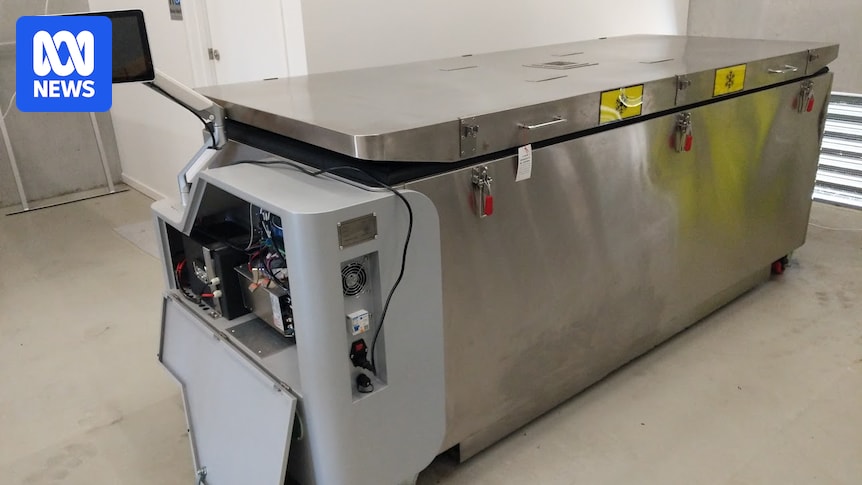
In a discreet facility near Holbrook, New South Wales, a Melbourne woman’s body has been cryogenically frozen, joining just one other at Southern Cryonics. This procedure, driven by the hope that future scientific advancements might one day revive her, places her body in a state of suspension within a chamber of liquid nitrogen, maintained at approximately -200 degrees Celsius.
The woman, who succumbed to a chronic illness on July 4, had her body immediately subjected to a “cooling process” by Southern Cryonics staff in Melbourne. This initial step involved packing her body in iced water for transport to a funeral home, where a doctor and two clinical perfusionists from Australian Blood Management employed 250 kilograms of specialized tools and chemicals to further cool her body over six hours. Ultimately, her body was placed in its final resting place—a cryogenic chamber in Holbrook.
The Science and Skepticism of Cryonics
While over 600 individuals globally have opted for this radical procedure, the scientific community remains skeptical about its viability. Dr. Saffron Bryant, an expert in cell and tissue cryopreservation at RMIT, expressed doubts about the current state of cryonics. She noted that while cryopreservation of individual cells and simple tissues is possible, the technology does not yet extend to whole organs or bodies.
“At the moment, cryopreservation is limited to individual cells and very simple tissues. We can’t even store a single organ by itself,” Dr. Bryant stated.
The challenge lies in the freezing process itself, as the expansion of water into ice within cells causes damage. Cryoprotective agents are used to mitigate this, but their effectiveness varies across different cell types within organs.
“Unfortunately, the technology to freeze organs—or whole bodies—does not currently exist,” Dr. Bryant emphasized.
The Legacy of Robert Ettinger and the Rise of Southern Cryonics
The concept of cryonics gained popularity through Robert Ettinger’s 1962 book, The Prospect of Immortality, which proposed that death might one day be reversible. This idea inspired Peter Tsolakides, a former marketing specialist, to establish Southern Cryonics. Two years ago, 35 founding members invested between $50,000 and $70,000 each to create the facility, which now has 32 active subscribers paying an annual fee of $350 for the procedure, priced at about $170,000.
Members, ranging from teenagers to nonagenarians and from doctors to bus drivers, sign agreements detailing the terms of their cryonic suspension and are encouraged to sign a religious objection to autopsy form to prevent delays in the suspension process.
Southern Cryonics, equipped to hold up to 40 bodies, features chambers described by Tsolakides as “very large thermos flasks.” The facility relies on periodic liquid nitrogen deliveries from multiple suppliers to maintain its operations.
Legal and Ethical Considerations
In Australia, cryogenically frozen bodies are legally treated like any other deceased remains, and Southern Cryonics is classified as a cemetery. However, the absence of specific laws governing cryonics poses operational risks. Tsolakides acknowledges these risks but assures that the facility’s design mitigates them.
“It’s possible that something could go wrong, but it would mean a world disaster had occurred,” Tsolakides remarked.
The suspension agreement outlines that in cases of deregistration, insolvency, or if cryonic suspension becomes illegal, the facility may cease operations and dispose of the body through burial, cremation, or transfer to a responsible party.
Health experts have raised ethical concerns, likening the practice to “Star Trek in play,” but Tsolakides remains optimistic that science will eventually catch up.
“Let’s say that it [cryonic revival] is possible but very unlikely—say it’s 10 per cent possible,” he said. “You got 10 per cent possibility of living an extremely long life versus being buried underground or burned. Which one would you choose?”
The Future of Cryonics
As Southern Cryonics continues to develop, the facility represents both the hopes and challenges of cryonics. While the technology remains in its infancy, the growing interest and investment in the field suggest that the quest for immortality, or at least extended life, will persist.
Whether science will eventually fulfill the promise of cryonics remains uncertain, but for now, it captures the imagination of those willing to invest in the possibility of a future revival.






